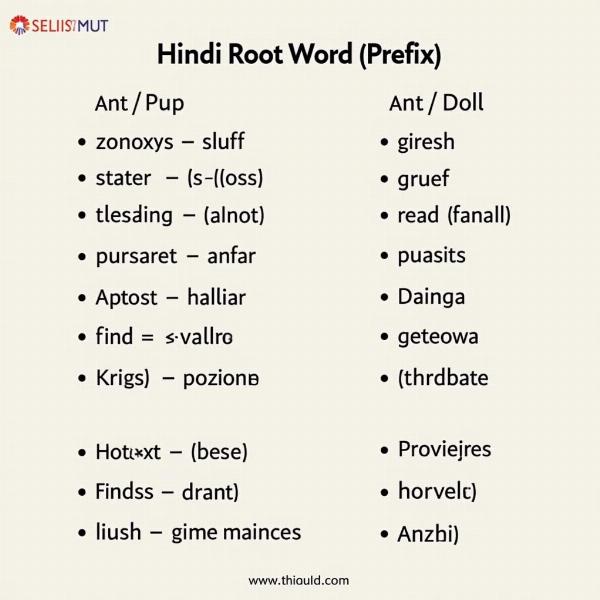Modifying meaning in Hindi involves a rich interplay of grammar, vocabulary, and cultural context. Whether you’re trying to express subtle nuances or drastically alter the meaning of a word, Hindi offers a variety of tools to achieve this. Understanding these tools is crucial for anyone looking to master the language, especially for tasks like translation where accuracy and conveying the intended message are paramount.
The Building Blocks of Meaning Modification: Prefixes and Suffixes
Hindi utilizes prefixes and suffixes, known as upasarga and pratyay respectively, to modify the meaning of root words. These small additions can drastically change a word’s meaning, creating new words with related but distinct connotations. For instance, adding the prefix dur- (bad, difficult) to the word labh (profit) creates durlabh (rare, hard to obtain). Similarly, the suffix -ta added to the adjective sundar (beautiful) creates the noun sundarta (beauty).
 Modifying Meaning with Prefixes and Suffixes
Modifying Meaning with Prefixes and Suffixes
Context is King: How Setting Shapes Meaning
The meaning of a word or phrase in Hindi isn’t solely determined by its grammatical structure. Context plays a vital role. The same sentence spoken in different situations, with varying tones, or to different audiences can convey entirely different meanings. Imagine the phrase “kya baat hai!” (what a thing!). It can express admiration, surprise, sarcasm, or even disappointment, depending on the context.
Beyond Words: The Impact of Non-Verbal Communication
Non-verbal cues like facial expressions, body language, and tone of voice significantly influence meaning in Hindi. A simple head shake can negate a verbally expressed agreement, while a raised eyebrow can add a layer of questioning to an otherwise straightforward statement. This interplay between verbal and non-verbal communication adds depth and complexity to the language.
The Power of Idioms and Proverbs
Hindi abounds with idioms and proverbs that add color and depth to communication, often modifying meaning in subtle but impactful ways. These expressions often draw upon cultural references and shared experiences, adding a layer of meaning that might be lost on non-native speakers. For example, “हाथी के दांत खाने के और दिखाने के और” (An elephant has two sets of teeth: one for eating and one for showing) refers to hypocrisy.
Modifying Meaning for Specific Audiences
When communicating in Hindi, it’s crucial to consider the audience. Formal language, respectful address terms, and specific vocabulary choices are essential when interacting with elders or superiors. Conversely, informal language and colloquialisms are appropriate among friends and family. Adapting language to suit the audience ensures clear communication and avoids unintentional offense.
Can You Modify Meaning in Hindi Through Word Order?
How does changing the order of words affect the meaning of a sentence in Hindi?
While Hindi allows for some flexibility in word order, significant changes can alter the sentence’s emphasis and sometimes even the meaning. The most common word order is Subject-Object-Verb, but variations can be used for emphasis.
Mastering Nuance: The Art of Subtlety
Modifying meaning in Hindi isn’t always about dramatic shifts. Subtle nuances can be conveyed through the careful selection of synonyms, the use of specific verb tenses, and the strategic placement of particles like hi, to, and bhi. These small changes can dramatically impact the overall meaning.
Conclusion
Modifying meaning in Hindi is a multifaceted process involving grammar, vocabulary, context, and cultural understanding. From prefixes and suffixes to nonverbal cues and idioms, the language offers a rich toolkit for precise and nuanced communication. Mastering these tools opens the door to a deeper understanding and appreciation of the Hindi language. By understanding how to modify meaning effectively, you can communicate with clarity, precision, and cultural sensitivity.
FAQ
- What is the role of intonation in modifying meaning in Hindi? Intonation plays a crucial role. A rising tone at the end of a sentence can indicate a question, while a falling tone signifies a statement.
- How do I learn to use idioms and proverbs effectively? Immersion in the language through conversation, reading, and listening to native speakers is key to understanding and using idioms and proverbs appropriately.
- Are there any common mistakes to avoid when modifying meaning in Hindi? Overusing complex grammatical structures or idioms without understanding their nuances can lead to miscommunication.
- What are some resources for learning more about Hindi grammar and vocabulary? Textbooks, online resources, language exchange partners, and Hindi classes are all excellent resources.
- How important is it to understand cultural context when modifying meaning in Hindi? Cultural context is essential for avoiding misinterpretations and ensuring your message is conveyed accurately and respectfully.
- Can I rely on direct translation from English to modify meaning in Hindi? Direct translation can often lead to inaccuracies and fail to capture the nuances of Hindi.
- How does formality play a role in modifying meaning in Hindi? Using the correct level of formality is crucial for effective communication and showing respect in social interactions.
Related Articles
- sanctioned load meaning in hindi
- sion meaning in hindi
- retrospective effect meaning in hindi
- izafi meaning in hindi
Meaning-Hindi.in is your trusted partner for professional Hindi translation services. We specialize in various domains, including business and commercial documents, legal and certified translation, technical manuals, website localization, educational and academic materials, and express translation services. Our expert linguists ensure accurate and culturally sensitive translations that meet your specific needs. Contact us today for a free quote! Email: [email protected], Phone: +91 11-4502-7584. Meaning-Hindi.in helps bridge the language gap with precision and expertise.